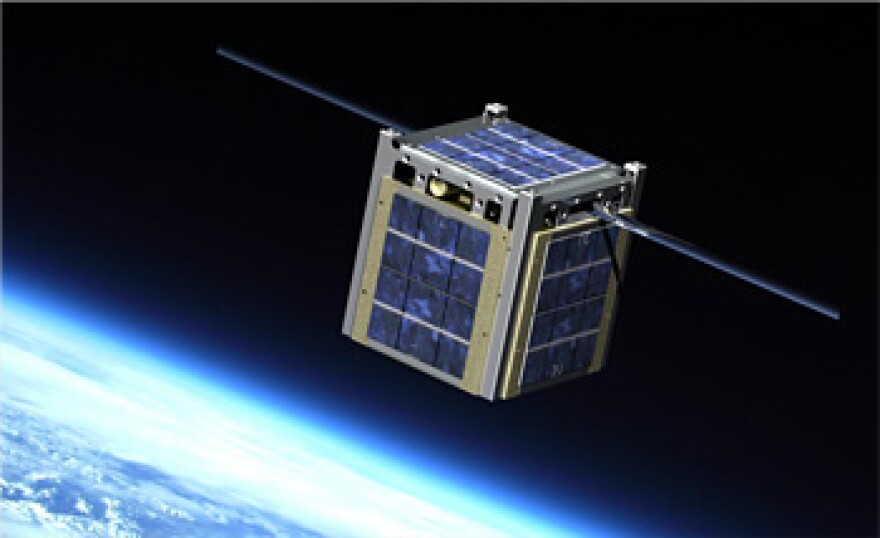Historically, missions executed by NASA (and others) were on a grand scale – massive spacecraft built with massive budgets and a massive labor force, but in the past decade, an education and industrial focus has emerged on sending nano-satellites, known as CubeSats, into orbit (so named for their cubical shape).

For some size perspective, standard CubeSatshave dimensions of 10cm x 10cm x 10cm - roughly the size of a coffee cup. In contrast, a standard GPS satellite is roughly the size of a bus.
Currently, universities and research institutions across the world are using CubeSats.
One prominent group in the CubeSat scene is the Michigan Exploration Laboratory (MXL), a research lab under the guidance of Dr. Jamie Cutler at the University of Michigan.
This past Saturday (Jan. 31), MXL successfully launched their CubeSat GRIFEX, adding to the CubeSat legacy that is redefining our nation’s approach to space exploration.
The GRIFEX hitched a ride into space aboard a rocket carrying NASA's soil moisture mapping mission. Here's the launch:
http://youtu.be/UoIu0z8orC8
The history of CubeSats
The first CubeSats were launched in the early 2000’s and were conceived of by researchers at Stanford University and Cal Poly in 1999.
During those formative first few years, CubeSats were almost exclusively used for education purposes, providing an opportunity for university students to design and test hardware and systems firsthand.
At the time, it would have been hard to predict the transformation of CubeSats from an educational tool into a full-blown industry.
CubeSat technology has experienced an "explosion in growth" in the past few years...
According to Scott Higginbotham, Mission Manager in the Ground Processing Directorate at NASA’s JFK Space Center, CubeSat technology has experienced an “explosion in growth” in the past few years, with the industry taking off “like a mind-boggling roller coaster ride.”
Higginbotham says people can buy CubeSat parts with "as little as a Google search."
He says they can design and construct their own nano-satellites or contract the construction to other groups. Instead of costing hundreds of millions of dollars like traditional satellite units, CubeSats can now be built for as little as several thousand.
Public engagement
What are the consequences of this proliferation of CubeSat technology?
Logan Sisca, Command and Data Handling Lead for MXL, says exploration of science from space is opening to more people.
"This has even allowed high school students to launch CubeSats."
"The barrier to entry for the general public is also fairly low due to the use of commercially-available components," says Sisca. "This has even allowed high school students to launch CubeSats, and amateur radio operators around the world can contribute to on-orbit operations by receiving telemetry beacons."
The increased access to space means more individuals can contribute ideas and research to the scientific community, potentially broadening our scientific knowledge.
For students, access to space can be an invaluable learning experience.
"The skills [students] gain while designing, building, and testing a real satellite can be directly applied to their coursework and industry positions," says Sisca. "Many of our alumni are now responsible for rockets and spacecraft systems at organizations such as SpaceX and Jet Propulsion Lab."
NASA in encouraging these educational opportunities. It instituted the CubeSat Launch Initiative through its Educational Launch of Nanosatellites program (ELaNa).
The CubeSat Launch Initiative (CSLI) enables the launch of CubeSat projects designed, built and operated by students, teachers and faculty to obtain hands-on flight hardware development experience. CSLI also provides access to space for CubeSats developed by the U.S. government and non-profit organizations giving all these CubeSat developers access to a low-cost pathway to conduct research in the areas of science, exploration, technology development, education or operations.
Since the program started, NASA has selected more than 100 CubeSats to be a part of the program.
GRIFEX has been at if for almost a week

The purpose of the GRIFEX mission is to test a new imaging sensor for JPL that will provide researchers with coastal and air pollution data. GRIFEX will allow JPL to test and debug their sensor on a smaller scale before constructing a larger, more expensive version.
On Saturday, MXL picked up the first beacon signals from GRIFEX, confirming that the satellite was functioning properly in low-earth orbit. Since then, GRIFEX has steadily relayed data that is currently being decoded by the MXL team.
It is predicted that GRIFEX will complete its mission requirements in a month, but it will stay in orbit around Earth for several years.
This successful CubeSat mission is the fourth executed by MXL.
Future missions for CubeSats
It is hoped that in the not-so-distant future, CubeSats will travel beyond low-earth orbit to explore the moon, near-Earth asteroids and the sun.
NASA says it has plans for a mission that will use two CubeSats to communicate with the mission’s Mars lander. Already, the NASA Ames research center has been using CubeSats for conducting biology experiments. The researchers say these CubeSats provide a “cleaner” environment than manned missions.
"We don't have to build Battlestar Galacticas all the time anymore. So why would we?"
This year, ELaNa plans to launch five more missions.
NASA's Scott Higginbotham foresees NASA continuing to put more energy into these CubeSat missions.
"These [CubeSats] aren’t just a novelty," Higginbotham says. "They aren’t going away. Electronics get smaller. Theoretically, one can do in a 3-pound CubeSat what one had to in several hundred pounds a few decades ago. We don’t have to build Battlestar Galacticas all the time anymore. So why would we?”
- Ari Sandberg, Michigan Radio Newsroom
*Editor's note: the author is a research student for the Michigan Exploration Lab working on an upcoming CubeSat mission.




